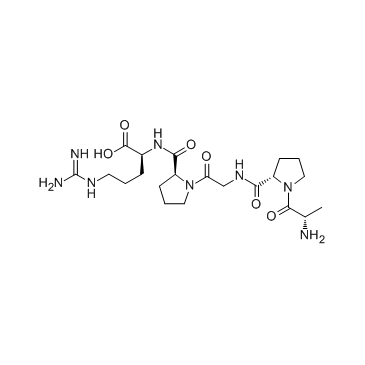117830-79-2
| Name | (2S)-2-[[(2S)-1-[2-[[(2S)-1-[(2S)-2-aminopropanoyl]pyrrolidine-2-carbonyl]amino]acetyl]pyrrolidine-2-carbonyl]amino]-5-(diaminomethylideneamino)pentanoic acid |
|---|---|
| Synonyms |
CLAP
H-Ala-Pro-Gly-Pro-Arg-OH Enterostatin human APGPR APGPR Enterostatin Ala-pro-gly-pro-arg Procolipase activation peptide ALA-PRO-GLY-PRO-ARG Enterostatin, human, mouse, rat |
| Description | Enterostatin, human, mouse, rat is a pentapeptide that reduces fat intake. |
|---|---|
| Related Catalog | |
| Target |
Human Endogenous Metabolite |
| In Vitro | In the perfused ratpancreas, Enterostatin, at 100 mM, inhibits the insulin response to 9 mM glucose (by 70%), 0.1 mM tolbutamide (by 40%), and 5 mM arginine (by 70%)[1]. |
| In Vivo | Chronically, enterostatin reduces fat intake, bodyweight, and body fat. This response may involve multiple metabolic effects of enterostatin, which include a reduction of insulin secretion, an increase in sympathetic drive to brown adipose tissue, and the stimulation of adrenal corticosteroid secretion[2]. Enterostatin enhances memory consolidation after central or oral administration at a dose of 10 nmol/mouse or 300 mg/kg, respectively, in a step-through type passive avoidance test in mice[3]. A dose of 38 nmol of enterostatin gives a significant inhibition of high-fat food intake, while at a higher dose of 76 nmol the inhibiting effect is lost. During the first hour, after injection of enterostatin, there is even a slight increase in food intake[4]. |
| References |
| Density | 1.54g/cm3 |
|---|---|
| Molecular Formula | C21H36N8O6 |
| Molecular Weight | 496.56100 |
| Exact Mass | 496.27600 |
| PSA | 224.04000 |
| Index of Refraction | 1.681 |
| Storage condition | -20°C |
| Hazard Codes | Xi |
|---|

